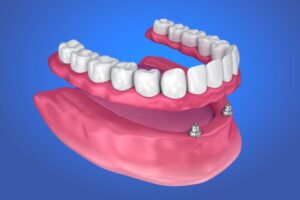What is it?
Overdentures, also known as implant-supported dentures or removable implant-supported dentures, are a type of dental prosthesis that is supported by dental implants. Unlike traditional dentures, which rest on the gums and rely on suction or adhesive for retention, overdentures are anchored securely to dental implants, providing increased stability, support, and functionality. Here’s an overview of overdentures:
- Indications:
- Overdentures are often recommended for patients who have lost all or most of their natural teeth and have insufficient bone density or quality to support fixed dental implants or bridges.
- They are particularly beneficial for patients who struggle with loose, uncomfortable, or poorly fitting traditional dentures, as overdentures offer improved stability, retention, and comfort.
- Implant Placement:
- The first step in the overdenture process involves the placement of dental implants in the jawbone. The number and location of implants vary depending on factors such as bone density, jaw anatomy, and the specific requirements of the case.
- Typically, a minimum of two to four implants are placed in the jawbone to support an overdenture. In some cases, additional implants may be placed for increased stability and support.
- Healing and Osseointegration:
- After implant placement, a healing period of several months is usually required to allow for osseointegration, the process by which the implants fuse with the surrounding bone tissue.
- During this time, temporary restorations may be worn to maintain aesthetics and function while the implants heal and integrate with the jawbone.
- Prosthesis Fabrication:
- Once osseointegration is complete, the dental implants are ready to support the overdenture.
- The overdenture is custom-made to fit securely over the dental implants and restore function and aesthetics. It may be fabricated from acrylic, composite resin, or a combination of materials.
- Special attachments or connectors are used to secure the overdenture to the implants, providing stability and retention while still allowing for easy removal and cleaning.
- Placement and Adjustment:
- The overdenture is placed and adjusted by the dentist to ensure proper fit, comfort, and function.
- The dentist will check the bite, occlusion, and aesthetics of the overdenture to ensure that it meets the patient’s expectations.
- Any necessary adjustments or modifications are made to optimize the fit and comfort of the overdenture.
- Postoperative Care and Maintenance:
- After the overdenture is placed, the patient will receive instructions on postoperative care and maintenance.
- Good oral hygiene practices, including daily brushing, flossing, and regular dental check-ups, are essential for maintaining the health of the implants and surrounding tissues.
- The overdenture should be removed and cleaned regularly to prevent plaque buildup, bacterial growth, and irritation of the gums.
Overdentures offer several advantages over traditional dentures, including improved stability, retention, and chewing efficiency. They can enhance the quality of life for patients with missing teeth by restoring oral function, aesthetics, and confidence. If you are considering overdentures as a treatment option, it’s important to consult with a qualified dentist or prosthodontist to determine the best treatment plan for your individual needs.

